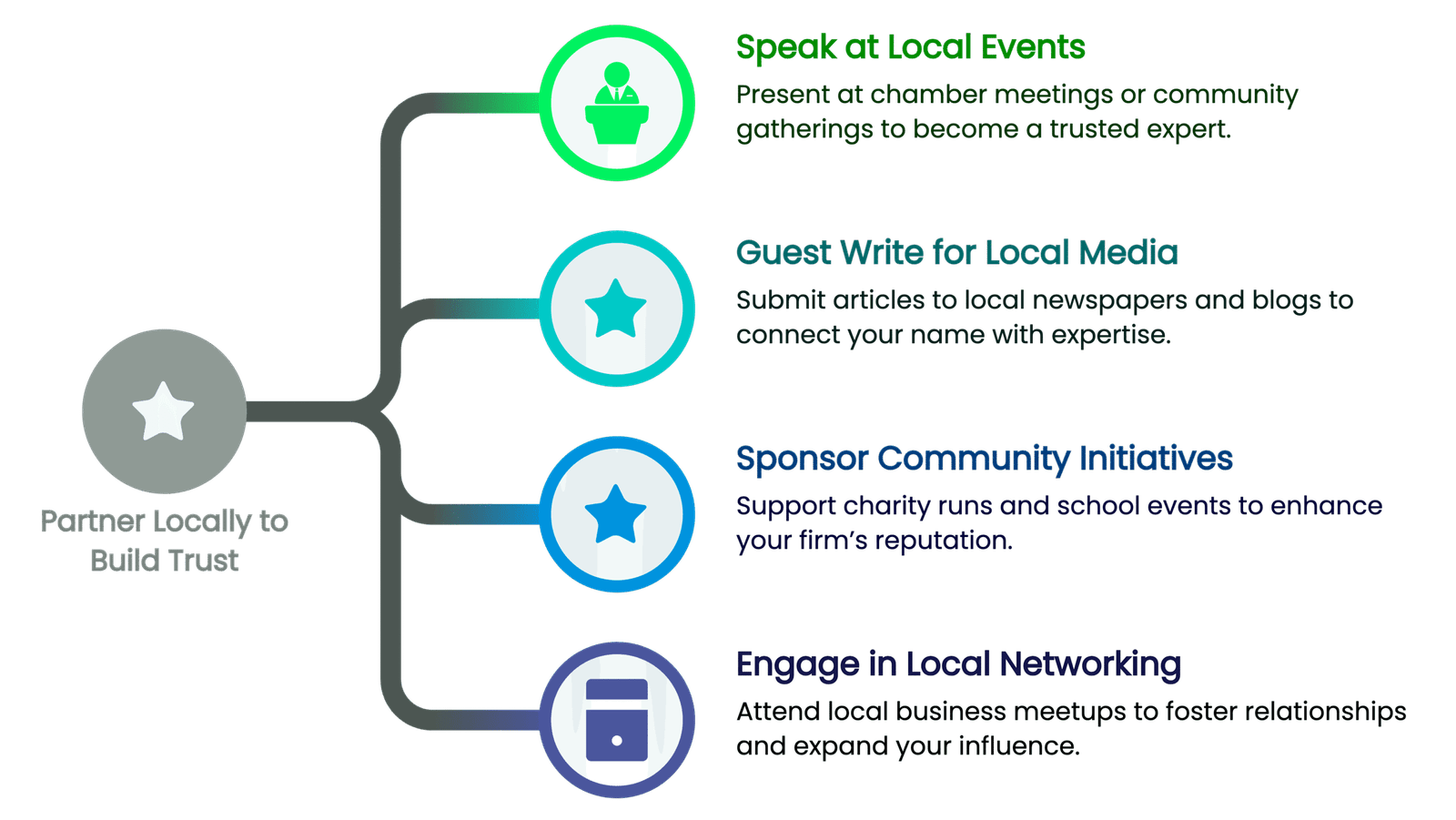Word of mouth used to be the lifeblood of any law practice. Today, online reputation carries equal weight. Prospective clients glance at your Google Business reviews, browse your LinkedIn posts, and read comments on your blog long before they pick up the phone. In a sea of firms, your reputation becomes the beacon that guides them to you.
Reputation management isn’t a once-and-done task. It’s an ongoing commitment to delivering outstanding service, gathering honest feedback, and addressing concerns head-on.
Delight Clients with Exceptional Service

Your reputation starts in the conference room and courtroom. Nothing replaces genuine care and clear communication.
Set Expectations Clearly
At the first meeting, outline your process: how you’ll gather information, what documents you need, and your anticipated timeline. If you expect to file motions within two weeks, say so. When you over-deliver on those promises, filing in ten days instead of fourteen, clients feel relief and trust deepens.
Communicate Proactively
Don’t make clients chase you for updates. After filing a document or attending a hearing, send a brief note:
“Hi Maria, I filed the motion today and expect a response in about three weeks. I’ll update you as soon as I hear back.”
Those little messages add up. Clients appreciate knowing where they stand, and they remember how easy you made the process.
Show Empathy in Every Interaction
Legal issues feel intensely personal. When you listen, really listen, to a client’s concerns, you show them respect. If a client breaks down explaining their financial worries, pause, acknowledge their feelings, and say, “I understand how stressful this is. We’ll handle the paperwork and deal with the court so you can focus on moving forward.” That human touch sticks with people long after the case closes.
Celebrate Milestones Together
Winning a motion or reaching a settlement isn’t just business; it’s someone’s life changing for the better. Send a congratulations email, call to share the good news, or drop off a small gift, like a branded notepad or coffee mug, to mark the moment. Clients who feel celebrated become enthusiastic advocates.
Claim, Polish, and Own Your Google Business Profile

Your Google Business Profile (GBP) often forms a prospect’s first impression. Treat it as your digital front door.
Verify and Complete Every Field
Head to your GBP dashboard, claim your listing, and verify ownership. Then fill out every detail:
Address: Ensure your office location matches what appears on your website and directory listings.
Hours: Update holiday closures or extended hours for consultations.
Services: List each practice area with clear, jargon-free descriptions.
Attributes: Add “Online appointments available” or “Free initial consultation” if you offer them.
A full profile signals to both Google and clients that you’re active and trustworthy.
Upload Compelling Photos
Static headshots won’t cut it. Post high-quality images of your team collaborating, your office space, and community events you sponsor. A picture of your attorneys volunteering at a local food bank tells a richer story than stock photos ever could.
Post Regular Updates
Treat GBP like social media. Publish a short post whenever you win a case, host a webinar, or publish a new guide. Even a monthly “Practice Tip” post, like “Top 3 Things to Check Before Signing a Lease”, keeps your profile fresh and gives prospects another reason to click.
Generate and Showcase Genuine Reviews

Online reviews function as modern-day word of mouth. Here’s how to build a steady stream of positive feedback.
Ask at the Optimal Moment
Timing shapes response rates. The best times to ask for a review include:
Right after a successful hearing or court victory
When you deliver final documents in a transactional matter
Immediately following a client’s expressed satisfaction in person or by email
A simple ask works best:
“I’m so pleased with the result we achieved today. Would you mind sharing a quick review on Google so others can benefit from what we’ve done?”
Make Leaving a Review Effortless
Cut friction at every step:
Generate a direct review link in your GBP dashboard.
Include that link in follow-up emails, thank-you cards, and SMS templates.
Create a branded QR code that clients can scan from reception or your business card.
The fewer clicks, the more reviews you’ll collect.
Highlight Reviews Everywhere
Don’t let stellar feedback sit hidden on Google alone. Pull snippets into:
Your homepage (“See why clients rate us 5 stars!”)
Service-area pages (“’[Attorney Name] helped me navigate my custody case with compassion and clarity,’ – A. Peterson”)
Email signatures (“Read our latest reviews on Google”)
Showcasing reviews builds trust for every visitor who lands on your site.
Monitor and Respond to Every Piece of Feedback

Your reaction to feedback tells as much of a story as the review itself.
Thank Positive Reviewers by Name
A brief, personal reply goes a long way:
“Thank you, John! I’m thrilled we resolved your case quickly. It was a pleasure working with you.”
These responses reinforce goodwill and show prospects you engage with your clients long after their case ends.
Address Negative Reviews with Professionalism
Negative feedback stings, but it offers a chance to demonstrate integrity:
Acknowledge the issue: “I’m sorry to hear about your experience.”
Propose a remedy: “Please call me directly at [number] so we can make things right.”
Take the conversation offline as soon as possible.
Prospects reading your response see you prioritize client satisfaction above ego.
Cement Your Authority with Client-Focused Content

Publishing helpful content positions you as an expert and gives people a reason to trust you before they ever pick up the phone.
Answer Real Questions in Plain Language
Sketch out a list of the questions clients ask most: “How long does a divorce take?” “What are my rights after a car accident?” Then write blog posts that answer those questions directly. Lead with the answer, follow with the steps or options, and close with a gentle call to action: “If you need help, schedule a free 15-minute consult.”
Share Case Studies and Success Stories
With client permission and anonymized details, outline how you tackled a tough challenge:
“When our client’s estate plan faced a six-figure estate tax liability, we restructured the trust and saved her heirs over $150,000 in taxes.”
Stories humanize your expertise and show impact.
Repurpose Across Channels
Turn a blog post into a short video, then share it on LinkedIn and Facebook. Extract five “legal tips” and create an email drip series. Each piece of content strengthens your reputation and broadens your reach.
Watch Your Mentions Online, and Offline
Your reputation lives everywhere people talk about you.
Set Up Alerts and Listening Tools
Use Google Alerts for your firm name and partners’ names. Deploy a social-listening tool like Mention or Hootsuite to catch brand mentions on Twitter, LinkedIn groups, or niche legal forums.
Monitor Legal Directories and Review Sites
Check Avvo, Justia, and your local bar association directory monthly. Ensure details stay accurate, respond to any feedback, and encourage happy clients to update profiles there too.
Spot and Seize Opportunities
When someone mentions you positively on Twitter, “Shoutout to @YourLawFirm for guiding me through my medical negligence claim!”, retweet it, thank them publicly, and amplify that praise.
Handle Negative Press with Calm and Strategy

Even the best firms face occasional bad press or critical blog posts. Your response strategy defines your long-term reputation.
Pause and Evaluate. Before you respond, gather facts.
Craft a Measured Public Reply. Acknowledge concerns without getting defensive.
Offer to Engage Privately. “We’d like to understand more, please reach out to us at [email/phone].”
Follow Through. Investigate, resolve, and if possible, ask the author to update their piece or review.
By demonstrating you care about fairness and resolution, you turn a potential PR crisis into a testament of your integrity.
Engage Consistently on Social Media
Social media gives you a direct line to prospects and referral partners alike.
Choose the Right Platforms
Pick two that suit your audience, LinkedIn for business and professional services, Facebook for local community engagement.
Maintain a Regular Cadence
Post once or twice a week:
Case Verdict Highlights (“We secured a 6-figure settlement for an accident victim.”)
Legal Tips (“3 Things to Check Before Drafting a Will.”)
Behind-the-Scenes (“Our team at the annual bar association luncheon.”)
When people see you active, and helpful, they remember your name when they need a lawyer.
Interact Authentically
Reply to comments, answer questions, and thank people for sharing your posts. These small touches reinforce your reputation as approachable and client-focused.
Partner Locally to Build Trust

Your reputation grows strongest where people know you best.
Speak at Local Events: Offer to present at chamber of commerce meetings or community group gatherings. You become the go-to expert in your region.
Guest Write for Local Media: Submit bylined articles to regional newspapers, business journals, or community blogs. When people see your byline, they connect your name with expertise.
Sponsor Community Initiatives: From charity runs to school events, your firm’s name on banners shows you invest in the community you serve.
These offline activities echo online and give clients multiple touchpoints to encounter, and remember, you.
Measure Your Reputation Health and Iterate
Reputation management thrives on data. Treat it like any other marketing channel.
Track Key Metrics
Review Count & Star Rating: Log your Google average weekly.
Sentiment Trends: Tag new feedback as positive, neutral, or negative. Watch for shifts.
Referral Sources: Ask every new client how they found you, reviews, social media, or word of mouth?
Hold Monthly “Reputation Reviews”
Gather your team for a 15-minute check-in. Celebrate raising your average rating. Identify recurring client comments. Assign one improvement, like speeding up response times or adding new practice-area FAQs. Small, consistent tweaks compound into a sterling reputation.
Your reputation stands at the intersection of exceptional service, genuine client feedback, and active engagement, both online and off. When you delight clients, gather and respond to honest reviews, publish helpful content, and monitor your brand across channels, you create a self-reinforcing reputation that pulls in new clients and referrals. Start today: pick one area, perhaps polishing your Google Business Profile or writing your first client success story, and commit to it. As you build on each win, you’ll watch your firm’s reputation grow into one of your most powerful assets.

